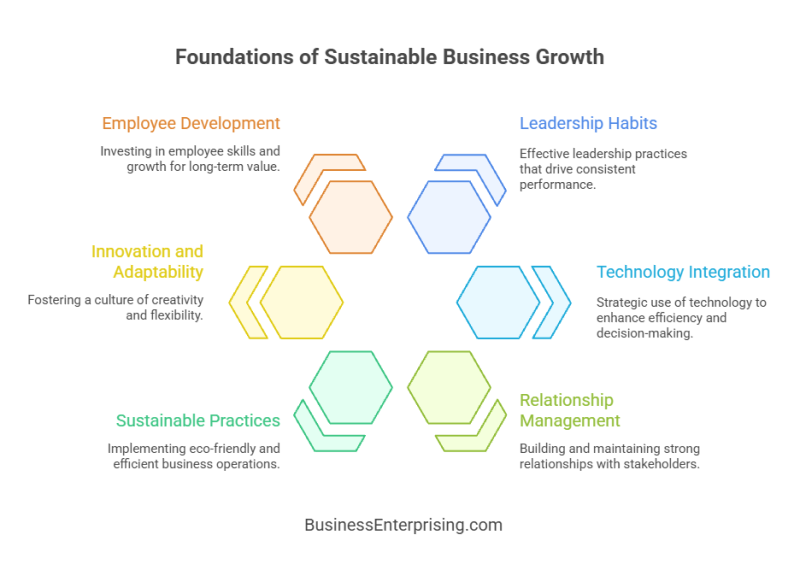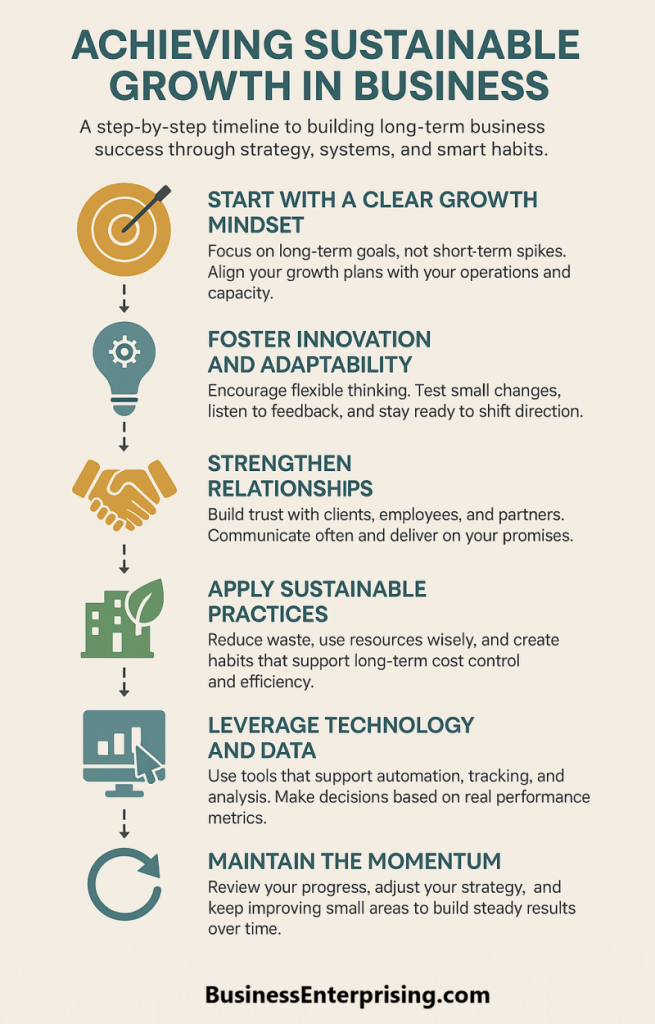
You also need to measure progress with the right tools. Data helps you track performance and avoid waste. Additionally, regular reviews help you stay aligned with your goals. That means fewer surprises and better decisions. Strong businesses focus on people. Whether it’s training employees or listening to customers, human input helps you grow smarter. Therefore, build habits that support both communication and performance.
Sustainability in business does not mean slow progress. It means growth that holds up under pressure. With the right approach, you avoid burnout, reduce turnover, and create lasting value. Additionally, your team can stay focused and productive without constant change. Running a stable, growing business takes work. However, that work pays off when your systems stay strong year after year. With consistent action and smart choices, your growth will support both profit and peace of mind.
Understanding Sustainable Growth
Growing a business takes more than hitting high sales numbers for one quarter. Real progress comes from growth that lasts over time. That means creating systems that support your team, your customers, and your finances without constant disruption. Additionally, steady growth depends on knowing your limits. Rapid expansion can strain cash flow, staffing, and service quality. Therefore, it’s better to grow with intention than to chase short-term gains. Each decision should support your long-term direction.
Achieving sustainable growth in business starts with clear goals. You need a plan that aligns resources with priorities. Additionally, your systems must be flexible enough to adapt when conditions change. That kind of structure supports steady results, even when the market shifts. However, sustainable growth does not mean avoiding risk. It means taking calculated steps that balance opportunity with capacity. As you test new ideas, track what works and adjust when needed. You want progress that builds momentum, not pressure.
Customer retention also plays a role. Growing by adding new clients is helpful, but keeping them brings long-term value. Therefore, invest in service and communication that keeps people engaged. Happy customers are more likely to return and refer others.
Lastly, review your metrics often. Know what success looks like beyond revenue. Track profits, productivity, and customer satisfaction. Additionally, talk with your team to spot what’s working and what needs to change. With steady focus, you can grow your business in a way that lasts. That’s the core of long-term success.
Fostering Innovation and Adaptability
Innovation keeps your business relevant. Adaptability helps it survive. Together, they form a core part of long-term business success. If you resist change, your growth slows. If you welcome ideas, your business stays prepared. Additionally, innovation does not always mean big changes. Small improvements to products or workflows can lead to better results. Therefore, give your team space to test new ideas and fix weak spots. Mistakes will happen, but progress often comes from trial and correction.
You also need to stay alert to what your market wants. Customer habits change quickly. New tools and platforms appear often. Therefore, the more flexible your thinking, the easier it becomes to shift and respond. However, adaptability requires structure. You need systems that allow change without causing chaos. That means setting priorities, tracking feedback, and adjusting as needed. When changes support your goals, they create momentum instead of confusion.
Achieving sustainable growth in business depends on staying open. Listen to your team and your customers. Ideas come from all directions, not only the top. Additionally, make time to review what’s working and what is not. Encourage learning and reward creative thinking. A team that feels heard will speak up more. That leads to better solutions, fewer delays, and smarter choices. Growth slows when a business stops adapting. Therefore, make innovation part of your routine, not a one-time fix. That habit builds confidence and keeps your company competitive.
Building Strong Relationships with Stakeholders
Strong business relationships build trust. Trust creates support during both growth and hard times. That support matters more than many realize. Without it, your business stands alone. With it, your business becomes stronger and more stable. Additionally, communication plays a key role. You need to stay clear, direct, and consistent with everyone you work with. That includes clients, vendors, partners, and your team. Therefore, set regular check-ins and make space for feedback. However, relationships are not built on transactions. They grow through reliability and respect. Follow through on promises. Listen more than you talk. These habits take time but make a difference.
Your employees also count. Treating them fairly builds loyalty and improves performance. Additionally, they interact with your customers every day. A motivated team helps protect your reputation and service quality. Clients want to feel valued, not processed. Therefore, stay responsive, ask questions, and remember the details. A strong client connection often leads to long-term business and referrals. Vendors and partners are part of your business too. Paying on time and sharing information strengthens your place in their network. That leads to better deals and stronger cooperation when you need help.
Achieving sustainable growth in business requires strong relationships. Without them, scaling becomes harder and slower. With them, you gain stability and support at every stage. Relationships are built over time through small actions. Therefore, treat them like assets, not tasks. They’re one of the few things that help you grow without increasing your costs.
Implementing Sustainable Business Practices
Sustainable business practices are more than environmental. They also support long-term efficiency, cost control, and brand strength. That makes them good business. When operations waste fewer resources, you gain both savings and reliability. Additionally, your team wants to work for a company that values smart use of time and materials. Efficiency keeps morale higher and stress lower. Therefore, review where you can reduce waste, automate steps, or reuse assets.
Clients also pay attention. They often prefer to work with businesses that show consistency and responsibility. That includes how you treat people and use supplies. Therefore, sustainable habits can help you win new business. However, good intentions don’t mean much without action. Start by choosing tools and vendors that support your goals. Then, apply the same thinking to daily work. A few smart changes can lead to better margins and smoother growth.
Track your results and share your progress with your team. Small wins add up. Additionally, you can use those examples to set goals and improve decision-making. A smarter process today helps avoid bigger problems tomorrow. Achieving sustainable growth in business means thinking long term. If your systems break under pressure, your gains won’t last. Therefore, build habits now that support steady results without draining people or resources. Sustainable business practices make you more adaptable. They also keep your business strong during shifts in cost, supply, or demand. Start simple, stay consistent, and focus on what supports both profit and stability.
Leveraging Technology and Data
Technology and data help you make smarter decisions faster. You can spot trends, fix problems, and improve customer service. These tools save time and reduce waste across your business. Additionally, tracking performance gives you better control over outcomes. You can measure results by channel, department, or product line. Therefore, you’re not guessing what works. You’re using facts. Clear data helps you focus on actions that support growth. However, tools alone don’t fix bad habits. You need to use them with purpose. Choose systems that match how your business actually works. Then, train your team to use those tools well. A simple setup that gets used is better than a complex one that gets ignored.
You also gain insight into customer behavior. With the right system, you can see what people want, when they want it, and how they respond. Therefore, you can improve service, fine-tune pricing, and plan better promotions. Additionally, automation helps reduce human error. It also frees up time for work that adds more value. You can automate tasks like scheduling, inventory updates, or reports. That gives your team more space to focus on growth.
Achieving sustainable growth in business requires consistency. That means using tech to build processes that scale. If your systems fall apart when things get busy, it limits your growth. Start by reviewing what slows you down. Then apply tools that fix those gaps. Use data to track what changes help most. That approach leads to smarter, more sustainable results.
Investing in Employee Development
Employees do more than fill roles. They shape your business each day through their actions, decisions, and service. Therefore, investing in their development builds long-term value. A skilled team works faster, solves problems better, and creates stronger results. Additionally, training supports retention. When people feel valued, they stay longer. That reduces turnover, which saves time and money. It also keeps your workplace stable and helps preserve customer trust. Therefore, small investments in learning can lead to stronger operations. However, development should match your business goals. Teach skills that support current roles and future needs. That makes training useful and relevant. It also shows that you’re thinking ahead, not reacting late.
You don’t need large budgets to make progress. Start by offering tools, guidance, and feedback. Additionally, give your team time to grow. A few hours spent learning each month can boost output across the year. Employees who grow tend to think differently. They see beyond tasks and look for ways to improve results. That mindset helps your business stay competitive and adapt when things change. Therefore, make development a regular part of your culture, not a one-time effort.
Achieving sustainable growth in business depends on the people behind it. You cannot scale without strong contributors who are ready to take on more. Training helps prepare them for those moments. Your team’s growth supports your business goals. Therefore, when you invest in people, you invest in progress that lasts.
Conclusion
Building a successful business takes more than hard work. It requires consistency, smart decisions, and a long-term mindset. Each step you take should support both your current goals and your future plans. Additionally, growth should not come at the cost of stability. Fast wins may feel rewarding, but they rarely last without a strong foundation. Therefore, focus on systems that support your business as it evolves. However, sustainable growth is not one idea or one habit. It is the result of many small actions done with care and purpose. From how you treat your team to how you use your tools, everything matters.
Achieving sustainable growth in business means creating something that can stand the test of time. You need to adapt, stay efficient, and keep your people engaged. That combination helps you stay ready for change without losing direction. Additionally, review your operations often. Each year brings new challenges, and your business needs to respond. Make time to update your tools, refresh your goals, and talk with your team. That regular attention keeps you on track.
Sustainability is not about doing everything perfectly. It’s about building habits that keep you moving forward, even when conditions shift. Therefore, stay focused on what drives results, not trends. Growth takes effort, but the right effort pays off. With clear goals and steady habits, you can run a business that lasts and succeeds.


